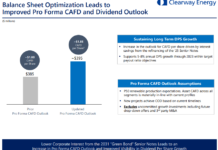Tom Konrad CFA
Conserving the planet for conservative investors.
Investing in clean energy stocks has an (often well-deserved) reputation for risk. Although energy efficiency and more inclusive progressive energy indexes have held up fairly well over the last few years, the performance of narrower clean energy sectors has been dismal, and some industry observers feel that the declines in wind and solar are structural (and hence permanent) as opposed to cyclical (and therefor temporary.)
This presents a conundrum for investors with long time horizons who not only need their investments to earn a steady return and meet long term financial obligations, but also care about the long term health of the planet. Individuals saving for retirement, as well as many pension funds and insurers match this profile.
Why should such long term investors care about the environment? Because runaway climate change has the potential to undermine the goals which they are saving to achieve. If a property insurer doubles its money by investing in businesses that increase the frequency of floods, droughts, and hurricanes, the financial gains will be undermined by an increase in claims. A retired couple will be happier and healthier on any given amount of money if the Florida condo where they planned to retire is not inundated by sea level rise, ocean acidification has not destroyed the coral reefs where they want to take their grand kids snorkeling, and they can feel optimistic about those same grand kids’ future health and economic well-being not being undermined by environmental toxins and energy insecurity.
Funding Clean Energy
There is a temptation to compare investing in clean energy to investing in information technology (IT), since both are rapidly advancing technologies that are disrupting old, inefficient ways of doing things. But clean energy is fundamentally different from IT in that it is very capital intensive. Lists of the most successful college drop-outs in history are dominated by IT moguls who started companies in their garages or with minimal capital: Bill Gates, Larry Ellison, Larry Page, Micheal Dell, Paul Allen, and Steve Jobs, are six of the top ten on one list I found.
It’s unlikely that the same list will be filled with clean energy entrepreneurs thirty years from now, because clean energy start-ups are capital-hungry, and college drop-outs have a harder time convincing investors to part with a few million dollars than businessmen with degrees and successful careers behind them. Clean energy projects are typically even more capital-intensive than traditional energy projects (with the exception of nuclear,) because the low fuel and operating expenses come at the cost of higher up-front costs.
According to an IEA 2010 report, between $600 billion and $1 trillion will be required every year until 2030 above existing infrastructure requirements in order to transition to a clean energy economy. The Stern report places the economic costs of avoiding dangerous climate change at approximately 2% of global GDP. Only the global bond market has the necessary amount of capital to deploy, but nearly all fixed income investments in low carbon technologies have very short maturities, and do not match the investment needs of the conservative institutions that would prefer green investments over brown ones, if they only had the option.
Climate Bond Initiative
The Climate Bond Initiative was founded in late 2009 to bridge the gap between the needs of fixed income investors and the needs of clean energy developers. The initiative’s goal is to catalyze the issuance of Climate Bonds to finance the global transition at speed and scale. To do this, the Initiative is developing the financial infrastructure necessary for the new class of Climate Bonds to emerge with the speed and scale necessary for the task at hand. Large pension funds such as the California State Teachers’ Retirement System, investor groups such as the Ceres Investor Network on Climate Risk, governments like the California State Treasurers’ Office, and nonprofits such as the Natural Resources Defense Council worked together to create a Climate Bond Standard which will be suitable for the broadest possible range of investors and projects, while still giving investors an assurance that the underlying projects are indeed helping to mitigate climate change.
The Climate Bond Standard was initially scheduled to be released at the end of July, but it was expanded to include a broader range of bond types, and so the release is now scheduled for this week.
For the Small Investor
The limited number of Climate Bonds issued to date have mostly been sold in the commercial market, but we can hope that the new Standard will catalyze the issuance of Climate bonds available to the retail investor as well. While retail investors are unlikely to provide a large fraction of the funding needed for the clean energy transition, retail investors can play important roles in helping to engage the public in the effort to tackle global warming, and help draw attention to the efforts of participating institutions.
In my opinion, retail Climate Bond offerings cannot come soon enough. When small investors see that green energy investing can not only be the right thing to do for the planet and our grandchildren, they are more likely to give political support to government initiatives that remove the barriers and confront the vested interests that are holding back the transition to a clean energy future.
Not to mention I’d like to buy a few Climate Bonds for my own IRA.
DISCLOSURE: None.








